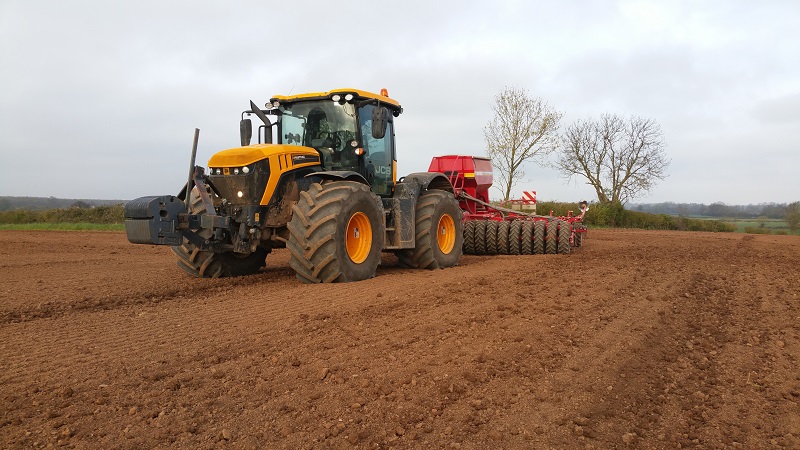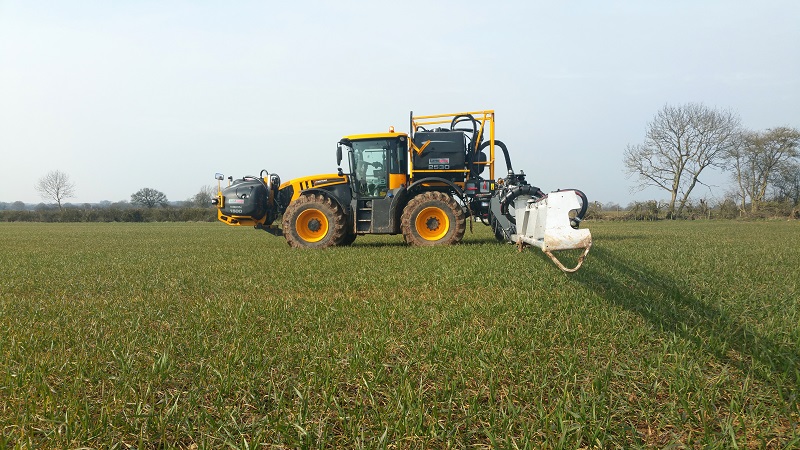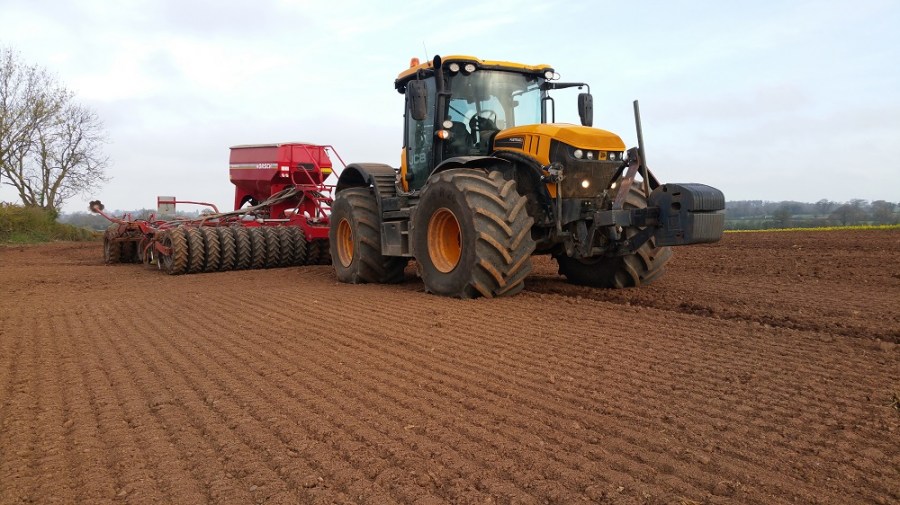The JCB Fastrac 4000 series, with its all-round suspension and now with CVT transmission has been billed as the most versatile and productive tractor ever made. CPM visits a Worcs family farm that’s had one for just over a year.
The Fastrac has the power to do heavy cultivations jobs and can tread lightly for delicate top work.
By Nick Fone
Having one machine on farm that’s capable of performing virtually every task seems like something of a pipedream. But for one Worcs family farm it’s come one step closer to reality.
With 400ha of arable cropping and 140 head of beef finishers on the books, J H Wormington and Son Ltd needs a versatile machinery fleet. But when Ian Wormington returned full time to the family business a year ago and started to take more work back in hand, he was conscious that splashing out on hefty machinery purchases to get all the work done wasn’t going to help with the health of the farm balance sheet.

The Fastrac’s combination of light footprint and relatively high power make it ideal for pulling the Wormington’s 6m Horsch Sprinter drill.
“Having worked away for a number of years and then come home, I didn’t want to change everything at once but clearly we did need to alter the way we were doing things to make best use of our skills.
“I’m a fully FACTS and BASIS-trained agronomist and have continued to keep up to date with that, doing two to three days a week for Agrii. Because of that it clearly made sense to bring the spraying back in-house. We’d had a local contractor doing it and we have such a good relationship with him that we didn’t want to lose that. We still use him for all our high clearance work – oilseed rape desiccation and late bean fungicides.”
With that intention in mind, Ian Wormington needed to source a machine suitable for the lion’s share of the farm’s agrochemical applications. He didn’t feel the business’ acreage could justify the expense of a self-propelled machine but also wasn’t keen on a trailed or mounted sprayer.

The front and rear tanks gives the Landquip sprayer a total capacity of 4000 litres – more than a match for a self-propelled.
“When I’m crop-walking I see way too much damage done by trailed machines backing into corners or even just in the headland turns, despite having tracking drawbars or steering axles.
“Even with front and rear tanks, mounted set-ups always seem to suffer a compromise with weight distribution so I wasn’t keen on that option either but that didn’t leave many other choices. In fact, the only thing left was a Fastrac de-mount.”
The timing of the sprayer search was somewhat fortuitous. JCB had just launched its new 4000-series Fastrac with self-levelling suspension and stepless CVT gearbox. Having driven a demo machine in the field, Ian Wormington was convinced it was the right tractor for the family business.
“When you get in a 4000 and drive it for the first time it feels revolutionary. The comfort at speed is just unbelievable – I was immediately sold on the concept.
“You can operate the Vario gearbox so it drives just like a self-propelled’s hydrostatic transmission – ideal for speed-sensitive work like spraying. Four-wheel steer makes it super manoeuvrable.
“But more important than all of that, the Fastrac is capable of doing virtually every job on the farm. It has the power to do heavy cultivations jobs and can tread lightly for delicate top work.”
Convinced that yellow was the colour, he then had to track down an appropriate de-mount spray-pack for the tractor.
“It’s traditionally either Knight or Landquip that have built sprayers for mounting on the back deck of the Fastrac so there wasn’t heaps of choice. When it came down to it we went with Landquip because they offered aluminium booms. Not only did I want to keep weight down but I also had in the back of my mind that we might one day want to go down the liquid fertiliser route and so corrosion-proof aluminium was a priority.”
With that decided, an order for a 1500-litre front tank and 2500-litre rear deck tank with 30m booms was placed at the same time that the Wormingtons signed up for a 217hp Fastrac 4220 with local dealer Lower Quinton Garages.
Now, 14 months since delivery, the tractor has clocked some 1300 hours, just over half of those accrued without the sprayer. Alongside a 269hp Deutz Fahr X720, the JCB is regularly hitched up to one of a pair of 3m Sumo Trio sub-soiler combination cultivators and has the job of getting nearly all the farm’s arable crops in the ground with a 6m Horsch Sprinter tine drill. Right up behind that it switches to a 10.3m set of Opico HeVa rolls which, allowing for a bit of overlap, fit perfectly with the sprayer’s 30m tramlines.
On top of that it occasionally gets coupled up to a 6m power-harrow and through harvest pulls a 14t Weeks trailer.
“Being relatively lightweight for the power, the Fastrac packs quite a punch and much of that’s down to the Sisu engine. It’s incredibly torquey despite only being the 6.6-litre block. We’d had the 7.4-litre in Masseys before and the JCB is more than comparable for lugging ability,” says Ian Wormington.
“Coupled up to the Fendt Vario gearbox it makes for an impressive combination. The option to run it in various modes means it can be incredibly fuel efficient or you can set it for all out pulling power.”
In its most basic guise for haulage, the JCB in-cab controller is used to select ‘Drive’ mode. Like an automatic car, that means a dose of right boot gets the tractor up to speed while a touch of the brakes slows it. For spraying and cultivations work he tends to switch to manual operation with engine revs and gearbox controlled independently. With the forward speed set through cruise control, it’s just a case of easing back on the headlands.
For spraying in particular, the ‘speed hold’ function means the tractor will automatically maintain forward travel and up revs as required when hills are encountered.
“The gearbox control software is very simple to use but clever in how it operates. For chemical applications it’s brilliant in holding a steady pace and despite running at 10-12km/h, the engine is generally only ticking along at 1300rpm. That means it really uses very little fuel for that type of work.
“With the KRM fertiliser spreader hitched on, I run it in rev-hold mode so that it keeps the pto speed constant while varying forward travel up and down banks. For heavy cultivations it can get a bit more thirsty and slightly frustratingly, the 390-litre fuel tank needs re-filling after 12 hours.”
For that work it’s often Ian’s father, uncle or cousin – James, Michael or Ed– who are in the driving seat. They tend to opt to run the transmission in ‘Power-shift’ mode with simulated steps making it act more like a conventional, more mechanical set-up.
“The controller’s menu screens are easy to navigate – it’s very intuitive, even for less computer-literate drivers,” continues Ian Wormington.
“But it’s not just the gearbox software that’s clever. The load-sensing, self-levelling suspension means the tractor sits and grips like a much heavier machine.”
A hydro-pneumatic, double-acting set-up with a ram at each corner connects the chassis to the axles. The suspension senses the weight the tractor is carrying several times a second and diverts the flow of oil accordingly. Not only does this keep things level and true but, by powering the wheels down into constant contact with the ground, it maintains traction – something previous Fastracs could reputedly struggle with.
“The 4000 grips where you would often expect it to spin. The Deutz uses its sheer bulk and weight to gain traction whereas the Fastrac is smarter. It would outpull a conventional tractor of a similar size and weight.
“Being load-sensing, the JCB just picks up the mounted Trio and as you pull forward it levels itself out. And on the sprayer that’s a brilliant facility to have – if you have different mixes on board you can empty the rear tank first and then switch to the front without having to worry about weight distribution – you know you’ll always get traction. That’s all down to the suspension and tyres.”
When the Fastrac first arrived it was delivered with two set of wheels – standard 600/70 R30s plus a set of 380mm wide row-crops on 34in rims. While these answered the requirements of most operations, for certain jobs something altogether chunkier was required.
“Despite the 600s having a relatively big footprint, for herbicide applications in late Jan they just couldn’t carry the weight of the tractor and sprayer,” explains Ian Wormington.
“It’s a big ask to bear over 8t of tractor plus 4000 litres of spray liquid across two axles on soft, wet ground and we were making too much of a mark. So in addition to the other two sets of wheels, we ordered a set of 750s which do a brilliant job of spreading the weight. It might seem like an extravagant expense but they’ll outlast the tractor and can be used for all the planting duties too. What price do you put on limiting damage to the soil?”
Compaction and soil care are big issues for the Wormingtons and spending money on decent rubber is not something they shy away from. The standard super single wheels on the farm’s 14t Weeks grain trailers have been swapped for 560mm wide Michelin Cargo Xbibs and where possible they’re limited to running on existing wheelings. Although not a true controlled traffic system, the use of GPS has meant drivers can stick to the same runs to avoid unnecessary compaction.
“If you’re going to criticise the Fastrac in any way, it’s the lack of an integrated ISOBUS and GPS controller. To start with we were making use of Landquip’s Arag control box with an EGNOS position feed but we wanted something a bit more sophisticated and accurate.
“We ordered a Trimble TMX 2050 screen and receiver with the Fastrac which we use for just about every job. It acts as an ISOBUS implement controller for the sprayer and drill and with Trimble’s Rangepoint correction we get 100mm accuracy.
“That means we’ve 10 section auto shut-off for the sprayer and for cultivations we can miss every other bout. That works really well when we’re running the two Trios together. With no GPS in the Deutz, it can run up and down every missed pass between the Fastrac’s satellite-positioned runs.”
The investment in a high specification spray pack has proved particularly worthwhile in Ian Wormington’s eyes. High capacity spray lines and a 600 l/min centrifugal pump mean flow rates are never an issue and, alongside the aluminium booms, should the farm convert over to liquid fertiliser there’ll be no need for an upgrade. Norac auto-height control keeps the variable geometry Pommier booms at an even height across the full width regardless of undulations. Front and rear tanks have separate clean water tanks and wash-out nozzles so while one is used to supply the booms, the other can be rinsed with the washings sent straight through the spray lines.
Hitching and unhitching is reckoned to be a 20min job, pipework for the front tank remaining on the tractor and quick connectors making coupling up a straightforward job. To get the rear tank off, the tractor’s suspension is jacked right up, legs attached to the frame and the four retaining bolts are removed. Having uncoupled the hydraulics and ISOBUS plug, it’s then just a case of unlatching the rear-deck locking pins, dropping the suspension down and driving out.
“Landquip have worked hard on making it as simple as possible to drop the sprayer on and off which means it doesn’t feel like a chore. That all helps in making the Fastrac a truly versatile machine and ensuring it can be used for other work unlike a self-propelled sprayer.”
Of course the downside of the set-up compared to a dedicated, standalone machine is the lack of ground clearance. But with the 34in row-crops and an under-belly sheet the Fastrac is able to make all the applications to the cereals and does everything in the rape right up to sclerotinia flowering sprays. That just leaves late bean fungicides and OSR desiccation for a high-clearance machine – a relatively inexpensive contractor’s bill in the grand scheme of things.
On the subject of costs, Ian Wormington believes the financial justification for the JCB and Landquip rig is relatively straightforward. Even with the tractor coming in somewhere close to £120,000, the fully-loaded spray-pack around £55,000 plus extra wheels and GPS adding a further £15,000, it’s still reckoned to be a cheaper set-up than a self-propelled of equivalent capacity. And of course, being so much more versatile and able to perform a much wider range of tasks, the cost can be spread that much further.
“The overall outlay is quite scary but it should be clawed back relatively quickly in saved contractor’s bills. The spray rig is probably slightly over capacity for our needs as they stand right now but it means we ensure timeliness and, actively looking for more contracting farming opportunities, we have the ability to cover extra ground as required.
“With the JCB we’ve pretty much fixed costs too. We opted for the 4000-hour, four-year warranty so we won’t have any nasty unexpected surprises.
“When we reach the end of that term we’ll probably swap the tractor for another of the same but keep the sprayer, wheels and GPS so that their cost can be spread yet further.”
As regards reliability, there’s very little to report. In the Fastrac’s 1300 hours at Patchetts Farm there have been a few simple hydraulic weeps and leaks to sort plus a gearbox re-calibration. Lower Quinton’s team have been quick to respond to any issues and generally have sorted things within a couple of hours. On the spray-pack there were a few teething troubles getting the Arag controller to talk to the Trimble GPS box and the Norac auto-height sensors have required some adjustment. That said, all in all it’s felt that it was definitely the right move.
“The main driver for the purchase of the Fastrac was a change in system with me coming back to the farm and bringing the spraying back in-house. High speed was never a major requirement for us – our furthest ground is only six miles away – but it certainly helps at harvest.
“Much more significant is the tractor’s stability at speed thanks to the suspension. That means we can comfortably travel at pace and it provides a steady base for the sprayer boom. The other major benefit is the way it generates traction – it’ll pull like a much heavier machine. It’s capable of doing proper field work and with the CVT it’s as good as a hydrostatic for speed sensitive jobs. Add the four-wheel steering into the mix and it’s the ideal spraying platform.”
Tech specs: JCB Fastrac and Landquip sprayer
- Model: 4220
- Rated Power: 217hp
- Max Power: 235hp
- Max torque: 950Nm @ 1450rpm
- Engine: 6.6-litre Sisu (Agco Power) with AdBlue
- Transmission: Two range Fendt stepless Vario CVT
- Suspension: Double-acting hydro-pneumatic self-levelling all round
- Hydraulics: 145-litres/min
- Rear linkage lift: 8t
- Wheelbase: 2.98m
- Turning circle: 9.8m
- Weight: 8.3t
- Service interval: 500 hours
- List price: £138,596
Landquip demount sprayer
- Tank capacity: 2500-litre demount with 1500-litre front tank
- Boom: tri-fold 30m Pommier Alu-light boom with Norac boom height control
- Pump: 600 l/min centrifugal
- Section control: GPS-controlled 10 section air auto-switching; continuous boom recirculation
Farm facts
JH Wormington and Son, near Bromsgrove, Worcs
- Farmed area: 400ha
- Cropping: Winter wheat 200ha (Skyfall for seed and Siskin for Group 2 buy-back); oilseed rape 90ha (HOL V316); marrowfat peas 45ha (Wherry and Sons); winter beans 45ha (Tundra seed crop); rotational silage leys 15ha plus permanent pasture
- Stock: 140 head of Belgian Blue X heifers finished at 18-20months, approx 70/yr
- Soil type: Medium to heavy clay loams
- Staff: Ian, James and Michael Wormington full time plus Michael’s sons Tom or Ed seasonal as required
- Mainline tractors: JCB 4220 Fastrac, Deutz Fahr X720
- Loader: JCB 541-70 Loadall
- Combine: New Holland CR9070 with 9m header
- Sprayer: Landquip demount for Fastrac with 2500-litre rear-deck tank and 1500-litre front tank and 30m booms
- Drill: 6m Horsch Sprinter
- Cultivations: 2x 3m Sumo Trio plus 7f Lemken plough




